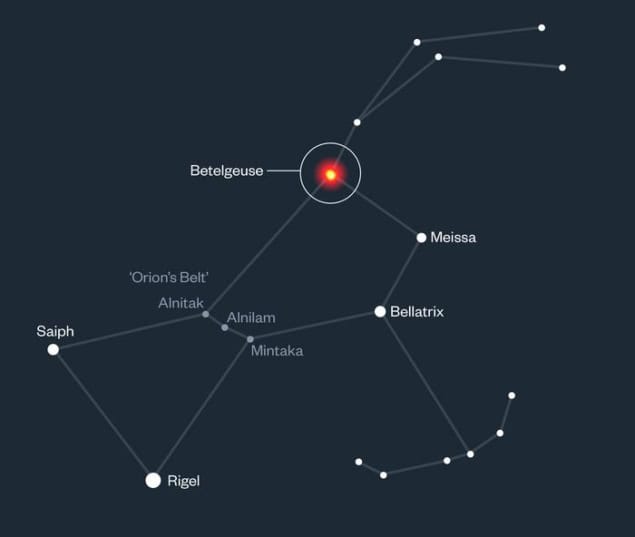Delayed Big Bang for dark matter could be detected in gravitational waves
 |
 |
Unlock the secrets of successful negotiations in a world where every interaction counts. "Focus on Systemic Negotiations" is a transformative guide for anyone seeking to excel in negotiations, regardless of their experience level. This compelling book equips beginners with foundational skills and empowers seasoned negotiators to refine their techniques in complex multicultural environments. Are you ready to elevate your negotiation game and confidently navigate even the trickiest personalities?

 Any buddy out there? Betelgeuse's position in the constellation Orion. (Courtesy: Lucy Reading-Ikkanda/Simons Foundation)
Any buddy out there? Betelgeuse's position in the constellation Orion. (Courtesy: Lucy Reading-Ikkanda/Simons Foundation)
NEW SMART E-BOOK ON AMAZON KINDLE PUBLISH ON 18th APRIL 2024
SYSTEMIC TECHNOLOGIES ECOSYSTEMS IN BUSINESS EXCELLENCE Kindle Edition
INVEST IN THE BOOK AND LEARN EVERYTHING ON THE SMART FUTURE CHALLENGING TECHNOLOGIES. DO YOUR RESEARCH ON THE MARKET AND INVEST YOUR MONEY IN THE FUTURE TECHNOLOGIES IN A SECURE AND CHALLENGING ECONOMIC ENVIRONMENT.
READ THE E-BOOK (NOW, YOU CAN ORDER A PAPERBACK PHYSICAL BOOK AVAILABLE ON AMAZON.COM), AND WRITE YOUR 5 STAR REVIEW ON THE BOOK (IF YOU HAVE SHOPPED ON AMAZON FOR AT LEAST 50 $ IN THE LAST 12 MONTHS).
AUTHOR: KONSTANTINOS P. TSIANTIS
IMPORTANT NOTICE FOR NON-AMERICANS OR AMERICANS: TO BUY THE EBOOK, YOU MUST HAVE AN APPLE ACCOUNT (NAME@ICLOUD.COM) AND MUST BE USER OF AN APPLE DEVICE, iPhone, MAC, OR IPAD.
Pros and Cons of Quantum Chromodynamics
PROS AND CONS OF QUANTUM ELECTRODYNAMICS
PROS AND CONS OF CLASSICAL ELECTRODYNAMICS
THE EXISTENCE OF NEGATIVE MASS AND ITS CONSEQUENCES IN OUR WORLD
Introduction
ΜΕΡΙΚΕΣ ΑΠΟΨΕΙΣ ΓΙΑ ΤΗΝ ΥΠΑΡΞΗ ΤΗΣ ΑΡΝΗΤΙΚΗΣ ΜΑΖΑΣ
ΓΙΑ ΝΑ ΔΙΑΒΑΣΕΤΕ Η ΝΑ ΚΑΤΕΒΑΣΕΤΕ ΤΟ ΑΡΧΕΙΟ ΜΕ ΤΙΣ ΜΕΡΙΚΕΣ ΑΠΟΨΕΙΣ ΓΙΑ ΤΗΝ ΥΠΑΡΞΗ ΤΗΣ ΑΡΝΗΤΙΚΗΣ ΜΑΖΑΣ ΠΑΡΑΚΑΛΩ ΠΑΤΗΣΤΕ ΣΤΟΝ ΕΠΟΜΕΝΟ ΣΥΝΔΕΣΜΟ ΕΔΩ
Centrifugation Method in Enrichment of Uranium, Development of Ballistic Missiles, and Nuclear Technology
Collapse of the Wave Function
Why is
it that more than half of the modern "interpretations of quantum mechanics deny the "collapse of the wave
function."
Why
are so many severe physicists and philosophers of science so unhappy with this
concept, which was a fundamental part of the "orthodox" theory
proposed in the late 1920s by the "founders" of quantum mechanics
- Werner Heisenberg, Niels Bohr, Max Born, Paul Dirac, Wolfgang Pauli, and Pascual Jordan.
We can
give the most straightforward answer in a single word - chance. Albert Einstein, the foremost scientist of all time (and ironically
the discoverer of chance in quantum mechanics, which he disliked
but never denied was a part of the quantum theory, as far as it could go in his
time) adamantly disliked the idea of "uncertainty" or
"indeterminism," the thought that some things in the universe were
not caused (or only statistically caused).
The idea of the wave function in quantum mechanics and its indeterministic collapse during a measurement is undoubtedly the most controversial problem in physics today. Of the several “interpretations” of quantum mechanics, more than half deny the collapse of the wave function. Some of these deny quantum jumps and even the existence of particles!
Wavefunction and Shrondiger equation and its significant explanation in the real world.
What do we know about dark matter and dark energy in our universe?
TO READ OR TO DOWNLOAD THE FILE PDF OF "WHAT DO WE KNOW ABOUT DARK MATTER AND DARK ENERGY IN OUR UNIVERSE PLEASE HIT ON THE FOLLOWING LINK HERE
What do
we know about dark matter and dark energy in our Universe?
THE STRUCTURE OF THE ATON AND THE NUCLEUS AND HOW STABLE IS THE NUCLEUS ACCORDING TO QUANTUM CHROMODYNAMICS
The uncertainty principle and its importance in quantum mechanics and the stability of atoms in nuclear physics
The Physics of Tachyons: What Are Tachyons?
ΓΙΑ ΝΑ ΔΙΑΒΑΣΕΤΕ Η ΝΑ ΚΑΤΕΒΑΣΕΤΕ ΤΟ PDF ΘΕΩΡΙΑΣ ΓΙΑ ΤΗΝ ΦΥΣΙΚΗ ΤΩΝ ΤΑΧΥΟΝΙΩΝ ΠΑΡΑΚΑΛΩ ΠΑΤΗΣΤΕ ΣΤΟΝ ΕΠΟΜΕΝΟ ΣΥΝΔΕΣΜΟ ΕΔΩ
The Compton Effect and Its Importance in Quantum Mechanics: Applications in Science and Modern Technology